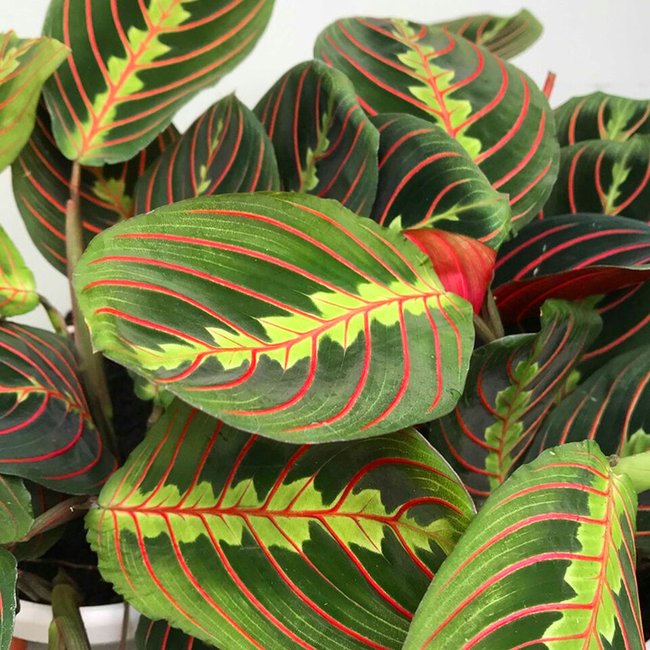Maranta
Maranta, commonly known as prayer plants, are a genus of flowering plants in the family Marantaceae. They are native to tropical and subtropical regions of the world, and are found in the Americas, Africa, and Asia.
Classification and Taxonomy
Maranta belongs to the family Marantaceae, and is closely related to the genus Calathea. The genus is named after Bartolomeo Maranta, an Italian physician and botanist.
Description and Characteristics
Maranta plants are herbaceous perennials with long, oval-shaped leaves. The leaves are typically green with various shades of purple and/or red on the underside. The flowers are small, white or pink, and typically bloom in the summer months.
Distribution and Habitat
Maranta plants are native to tropical and subtropical regions of the world, and are found in the Americas, Africa, and Asia. They prefer moist, shady environments and can be found in rainforests and other humid habitats.
Ecology and Reproduction
Maranta plants reproduce by seed and by vegetative means. The flowers are pollinated by hummingbirds, bees, and other insects.
Uses and Economic Importance
Maranta plants are popular as houseplants due to their attractive foliage and easy care. They are also used in traditional medicine.
Conservation Status
Maranta plants are not listed as threatened or endangered.
-
Is Maranta plant toxic to pets?
Maranta plants are considered non-toxic to cats, dogs, and other pets. However, it is still recommended to keep the plant out of reach of curious pets to prevent any accidental ingestion.
-
How do I propagate my Maranta plant?
Maranta plants can be propagated through division. Carefully remove the plant from its pot and gently separate the roots into two or more sections. Plant each section in a new pot with fresh soil and water thoroughly.
-
What is Maranta?
Maranta, also known as prayer plant, is a beautiful foliage plant that belongs to the family Marantaceae. It is native to tropical and subtropical regions of Central and South America.
-
How do I care for my Maranta plant?
Maranta plants thrive in bright, indirect light and require well-draining soil that is kept consistently moist. They prefer high humidity levels and temperatures between 60-75°F. Water your Maranta plant regularly, but avoid overwatering, as this can lead to root rot. Fertilize your plant with a balanced fertilizer every two weeks during the growing season.
-
How often should I water my Maranta plant?
Maranta plants prefer consistently moist soil, so it is important to water them regularly. However, be careful not to overwater, as this can lead to root rot. Water your Maranta plant when the top inch of soil feels dry to the touch.
-
How often should I fertilize my Maranta plant?
Fertilize your Maranta plant every two weeks during the growing season, which is typically spring and summer. Use a balanced fertilizer and follow the instructions on the packaging.
-
Why do the leaves of my Maranta plant curl up?
Curling leaves on a Maranta plant may indicate that the plant is not receiving enough water or humidity. Make sure to water your plant regularly and increase humidity levels by placing a tray of water near the plant or using a humidifier.
-
How often should I repot my Maranta plant?
Maranta plants prefer to be slightly root-bound, so they do not need to be repotted very often. Repot your Maranta plant every 2-3 years or when the roots become overcrowded in the current pot. When repotting, choose a pot that is only slightly larger than the current one, as too much extra space can lead to overwatering and root rot.
-
What pests and diseases should I watch out for with my Maranta plant?
Maranta plants are susceptible to a few pests and diseases, including spider mites, mealybugs, and root rot. Keep an eye out for any signs of pests, such as webbing or sticky residue on the leaves, and treat them promptly with an insecticidal soap. To prevent root rot, make sure to avoid overwatering and provide adequate drainage.
-
How can I revive a dying Maranta plant?
If your Maranta plant is showing signs of distress, such as wilting or yellowing leaves, there are a few things you can do to revive it. First, check the soil moisture level and adjust watering as needed. Increase humidity levels by misting the leaves or placing a tray of water near the plant. Trim any dead or damaged leaves and make sure the plant is receiving adequate light. If the plant is severely damaged, consider propagating a new plant from healthy sections of the original plant.
10 Fun Facts About
1. Maranta plants are known for their unique ability to move their leaves in response to light. 2. The leaves of Maranta plants are often used as a food source by local people in their native habitats. 3. Maranta plants are believed to bring good luck and fortune. 4. The genus Maranta is named after an Italian physician and botanist, Bartolomeo Maranta. 5. Maranta plants can be found in a wide variety of colors, including green, purple, red, pink, and white. 6. Maranta plants are popular as houseplants due to their attractive foliage and easy care. 7. Maranta plants are native to tropical and subtropical regions of the world. 8. Maranta plants reproduce by seed and by vegetative means. 9. Maranta plants are pollinated by hummingbirds, bees, and other insects. 10. Maranta plants are used in traditional medicine.
Pun
Maranta plants are so easy to care for, they practically pray for you!
Similar To
Calathea, Stromanthe, Ctenanthe, Thalia Keywords: Maranta, Prayer Plant, Marantaceae, Herbaceous Perennial, Houseplant, Tropical, Subtropical, Pollinators, Traditional Medicine









